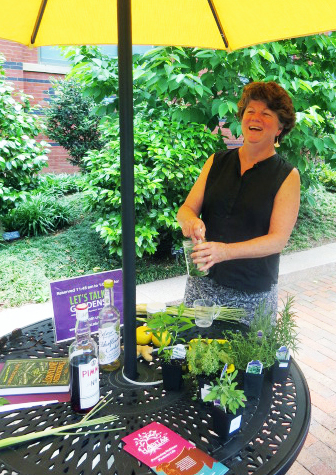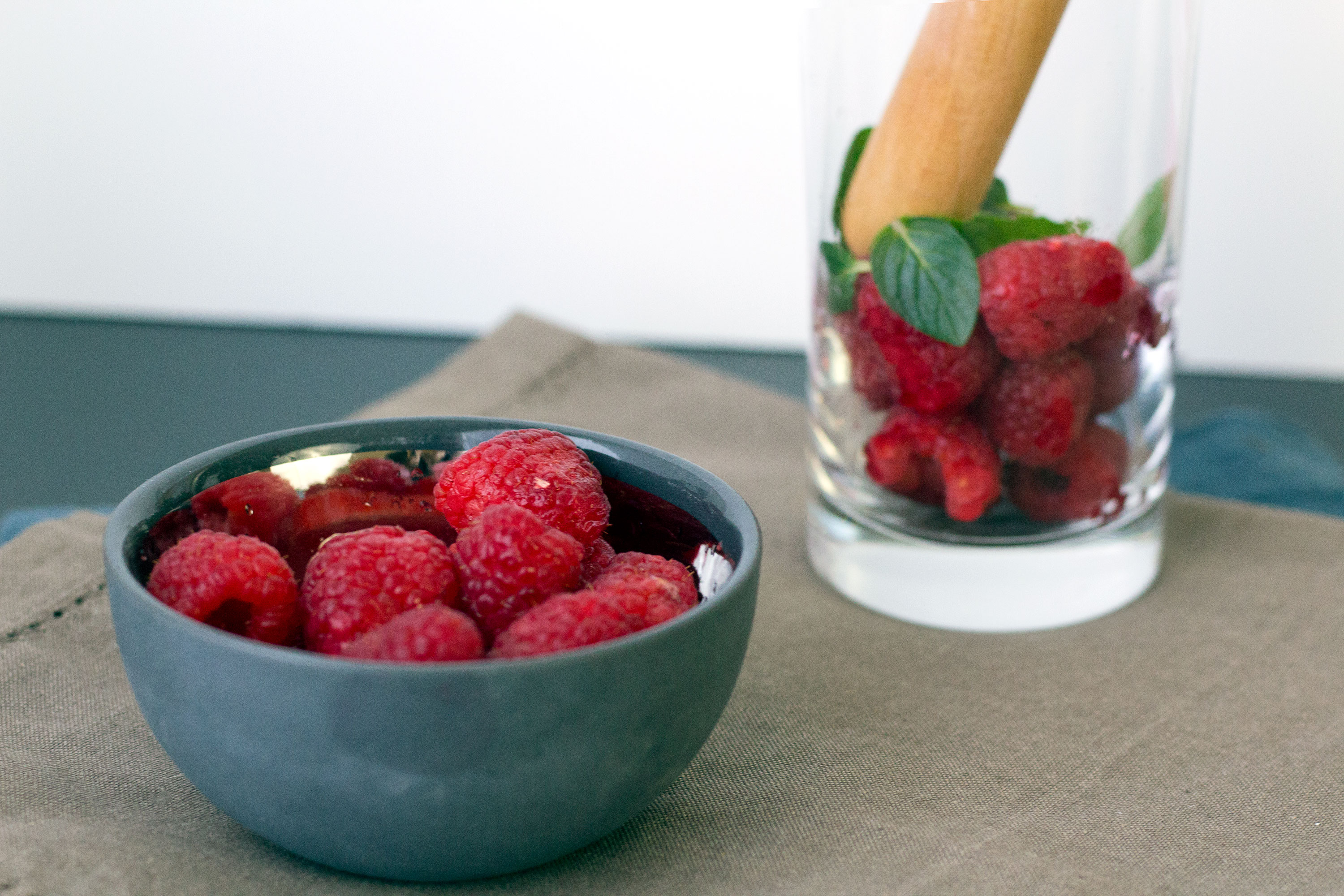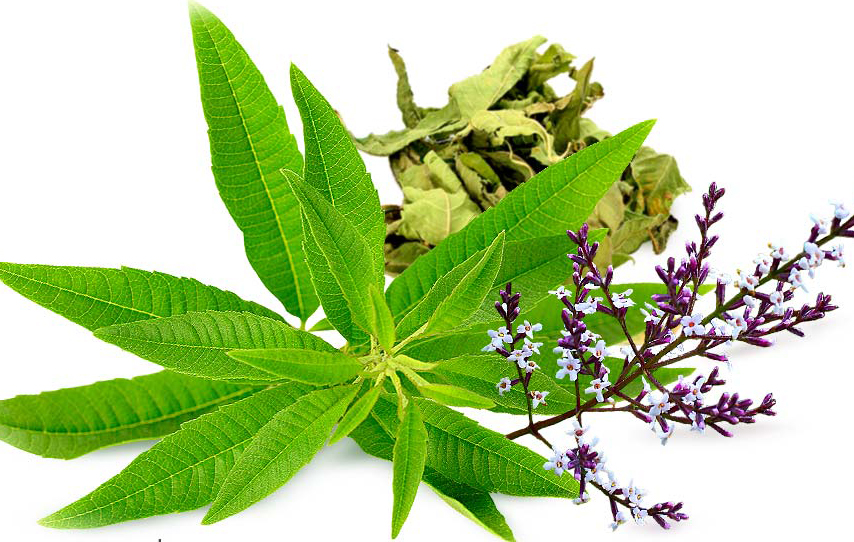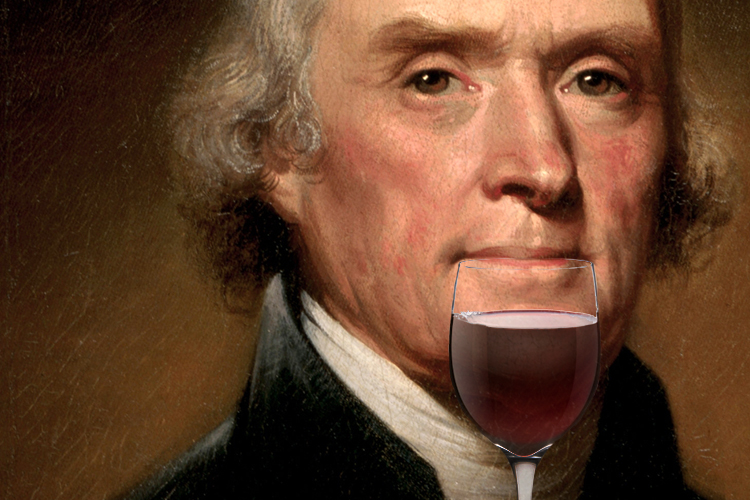Prune the shrubs? No thanks, we’d rather drink them.
Summer’s heat and humidity can make even the most dedicated gardeners wilt a bit and find themselves in need of refreshment. How about some booze with your botany? Cynthia Brown of Smithsonian Gardens shares a few of her favorite herbal cocktails.
“Syrup,” “smash” and “shrubs” were three words served up by Cynthia Brown, Smithsonian Garden’s Education and Collections Manager, during a presentation she gave on herbs and cocktails in the Enid A. Haupt Garden on a sweltering afternoon in late May.

Cindy Brown of Smithsonian Gardens demonstrates the delights of herbal cocktails. (Photo by John Barrat)
Shielded from the sun by a yellow umbrella and with a few herbs, books and brochures arranged before her on a table, Brown offered a novel use for some of the aromatic and flavorful plants you may have growing this summer in your garden.
“Why not think about spicing up your life by putting herbs in cocktails?” she asked. “One very easy way to do this is in a smash,” recommending one of her favorite herb-cocktails: the raspberry sage smash.
Sage may be familiar flavor in Thanksgiving turkey stuffing, Brown observed. “When I was in Tuscany it was the herb they used to brighten their steaks. Yet sage also has the ability to brighten fruit, like a lemon does,” which makes it a perfect complement for gin or vodka in a fruit-based cocktail.
A smash is also fun to make because to create it requires muddling, Brown adds, referring to the way the drink’s ingredients are mashed together in the bottom of a glass with a pestle. When it comes to herbs, fruit and cocktails “You can smash almost any combination and mix it together,” she observed.

Muddling requires crushing the fruit with a pestle or the back of a spoon. (Image via https://servingrealness.com/)
“Sage and rosemary are really very delightful in a cocktail,” Brown says. “My friends and I did a test on which of the herbs go better with the raspberries, and sage is the one we all liked even better than lemon verbena, mint or basil, because it seemed the brighten the fruit a little bit more.”
Raspberry-Sage Smash
6 ripe raspberries
3 – 4 fresh sage leaves
2 tsp. granulated sugar
Splash of vodka (optional)
“Smoosh everything up and make sure it has a nice syrupy look,” Brown says. “Then add your seltzer water or whatever.”
In addition to the smash, simple herb syrups are also easy to make, delicious and can be kept on hand in the refrigerator for personal use or when guests drop by unexpectedly.
“Lemon verbena is my favorite of all the lemon scented herbs out there,” Brown says. “It is closest to what lemon really smells like, it’s very easy to raise in a container or in the ground, and it gets to be the size of a shrub.”
Lemon Verbena Syrup
1 cup sugar
1 cup water
1/2 cup lemon verbena leaves from the garden
Heat water and sugar in a medium saucepan until the sugar dissolves.
Remove from heat and add lemon verbena leaves.
Steep for 15 minutes.
Cool in the refrigerator for 24 hours.
Strain leaves from syrup before using and keep refrigerated.
One of Brown’s favorite uses for lemon verbena syrup is to mix it with bourbon or a Japanese whiskey and then add chopped-up peaches. “Lemon verbena was made for peaches,” Brown says. “It is delightful.” This simple syrup can also be used with peaches alone (no alcohol) and poured over shortcake “to brighten the fruit and give that herbal note to it.”

Lemon verbena
(Image via Herbazest.com)
Bee’s Knees
A second simple syrup cocktail with an herbal note that Brown recommends is the Bee’s Knees. First make a lavender-honey simple syrup by heating 1/8 cup hot water (about 2 tablespoons) and stirring in 1/4 cup honey and 1 teaspoon of culinary lavender (found in spice rack at most groceries). Let cool 30 minutes, then pour through a fine mesh strainer to remove the lavender.
In a shaker with ice combine:
2 tablespoons (1 ounce) lemon juice
1 tsp culinary lavender
1.5 tablespoons of lavender syrup
2 oz. gin (about a quarter-cup)
Shake vigorously for 10 seconds.Double-strain the liquid into a cocktail glass and garnish with a sprig of lavender.
A “shrub”(from the Arabic word sharab, “to drink”), the third herbal cocktail recommendation from Brown, was the drink of preference in the days of Thomas Jefferson and George Washington to cool down during Virginia’s humid summers. It’s a delicious combination of sweetness and acidity, she says, “because you are using sugar and vinegar.”
Lemon Rosemary Shrub
Carefully peel two lemons, retaining only the zest in wide strips. (The zest is the yellow part of the peel; the white pith is bitter and should not be used.)
Coat the lemon zest with 3/4 cup of granulated sugar, turning the pieces to coat all sides. Place the sugared zest in a tightly sealed container and refrigerate overnight, periodically shaking the container to keep the peel coated with sugar.
Heat the sugared lemon peel and any remaining loose sugar in 3/4 cup water over low heat until the sugar dissolves.
Carefully remove the lemon zest without removing the sugar solution; scrape the lemon peel with a butter knife to remove any excess sugar. Set the lemon peel aside for another use or discard.
Add a 3- to 4-inch stem of fresh rosemary and refrigerate in a closed container for a second day. If the rosemary has not yet added its fragrant aroma to the concoction after a day, add more rosemary and refrigerate for another day.
Finally, add 1/2 cup of prosecco vinegar, champagne vinegar, club soda, seltzer or sparkling water to taste. Dry gin such as Tanqueray is optional.
“If you’ve never had a shrub, try it! It is very refreshing,” Brown said.

Thomas Jefferson was known to enjoy a refreshing adult beverage. (Image via Slate.com)
During her wide-ranging talk, Brown also discussed herbal tinctures, such as lavender gin; simple syrups made from elderflower, lemongrass, Thai basil and even native sumac (using the hairy sumac seedpod), which also has a lemony flavor.
Brown urged her audience to come up with their own combinations of herbs to enhance summer cocktails. She explained that the venerable British gin-based fruit drink Pimms, as well as many specialty Italian herbal liqueurs, are “more on the bitter side,” many being originally crafted as aperitifs to produce more saliva in one’s mouth before a meal so that food was more easily digested.
“As you start to age and your teeth begin to hurt, you don’t want to chew so much, so you need a little bit more saliva to help you digest your food. That’s what an aperitif is for—to whet the appetite and get you ready to eat.
“The digestive, again, is a bitter made with herbs and alcohol,” Brown continues, “so you digest your dinner and don’t go to bed with heartburn.”
For those who don’t have a garden to grow their own herbs, there are many ethnic and organic markets in the Washington, D.C., area where you can buy them, Brown says.
To learn more about the history of botany and booze, Brown recommends The Drunken Botanist by Amy Stewart.
Brown’s talk was part of the series “Let’s Talk Gardens,” free lunchtime talks and demonstrations on gardening basics by Smithsonian Garden’s horticulturists. The demonstrations take place Thursdays from 12:15-12:45 p.m. on the East side of the Enid A. Haupt Garden near the Arts and Industries Building through mid-October. For a schedule of upcoming program titles and more information on this series go to http://gardens.si.edu/whats-happening/lets-talk-gardens.html
Posted: 7 June 2019
- Categories:








